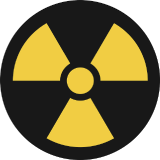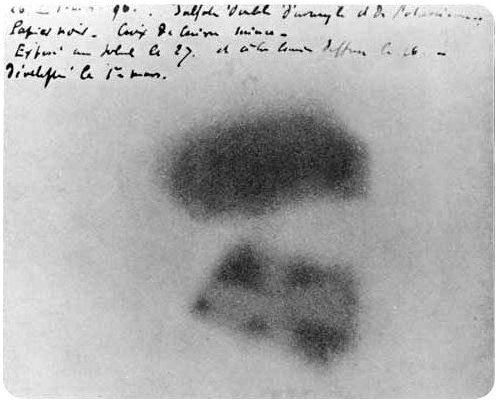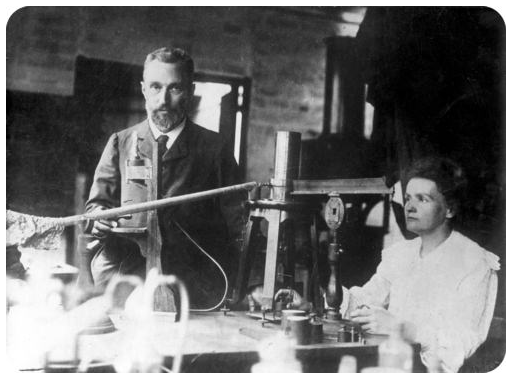24.1: Discovery of Radioactivity
- Page ID
- 53980

Figure \(\PageIndex{3}\): The radioactive danger symbol. (By Clkr-Free-Vector-Images(opens in new window); under Pixabay license)
If you visit the nuclear medicine department of a large hospital, you are very likely to see the symbol shown above. This sign means that radioactive materials are present, and special safety precautions need to be taken. These materials are used for the diagnosis and treatment of many diseases. The people using these materials are specially trained to handle them safely. Radioactive materials can be dangerous and should be respected, but need not be feared.
Discovery of Radioactivity
John Dalton first proposed his atomic theory in an 1804 lecture to the Royal Institution, a prestigious British scientific society. In this talk, he put forth the idea that all atoms of an element were identical, and that atoms were indestructible. In a little over 100 years, both of these ideas were shown to be incorrect.
In 1919, studies on atomic weights led Francis Aston (1877-1925) to the conclusion that some elements with different atomic weights were actually the same element in different isotope forms. Aston used a mass spectrograph to separate isotopes of different elements. He won the Nobel Prize in Chemistry for this work in 1922.
Natural Radioactivity
In 1895, Wilhelm Röntgen produced great interest around what caused the phenomenon of x-rays. One researcher of this phenomenon was Henri Becquerel. Becquerel studied the fluorescent properties of uranium salts, believing they had something to do with x-rays. He soon learned that uranium could expose a photographic plate without an external input of energy (thought to be needed to produce uranium fluorescence). Becquerel also showed that the uranium salt emissions could be affected by a magnetic field, which was not true for x-rays.

Pierre and Marie Curie studied the properties of uranium salts with the express purpose of identifying the details of these emissions. They were the first to coin the term "radioactivity", meaning the spontaneous emission of radiation in the form of particles or high energy photons, resulting from a nuclear reaction. The major contributions to the work came from Marie, who showed that the amount of radioactivity present was due to the amount of a specific element, and not due to some chemical reaction. She discovered the element polonium and named it after her native Poland. Madame Curie shared the 1903 Nobel Prize in Physics with her husband Pierre and Henri Becquerel. She won the Nobel Prize in Chemistry in 1911.

Ernest Rutherford, a later researcher, was able to demonstrate three different types of radioactive emissions. These emission types differed in terms of mass, charge, and their ability to penetrate materials. He designated them simply as alpha \(\left( \alpha \right)\) emissions, beta \(\left( \beta \right)\) emissions, and gamma \(\left( \gamma \right)\) emissions.
Radioactivity involves the spontaneous emission of material and/or energy from the nucleus of an atom. The most common radioactive atoms have high atomic numbers and contain a large excess of neutrons. Some typical radioactive elements are technetium (atomic number 43), promethium (atomic number 61), and all elements atomic number 84 (polonium) and higher. There are four primary types of emission, either involving the release of a particle from the nucleus or the release of energy. In many instances, both energy and a particle are produced by the radioactive event.
It should be noted that some elements considered to be stable do have radioactive isotopes. Carbon-14 is radioactive, but this isotope is only a small fraction of the total amount of carbon in existence (about one part per trillion carbon atoms). Hydrogen also has a radioactive isotope known as hydrogen-3 or tritium, again a very small fraction of the total elemental hydrogen present.
Summary
- Francis Aston discovered that some elements with different atomic weights were actually the same element in different isotope forms.
- Henri Becquerel showed that uranium salt emissions could be affected by a magnetic field, which was not true for x-rays.
- Marie and Pierre Curie were the first to coin the term radioactivity, meaning the spontaneous emission of radiation in the form of particles or high energy photons, resulting from a nuclear reaction.
- Ernest Rutherford, a later researcher, was able to demonstrate three different types of radioactive emissions: alpha \(\left( \alpha \right)\) emissions, beta \(\left( \beta \right)\) emissions, and gamma \(\left( \gamma \right)\) emissions.

